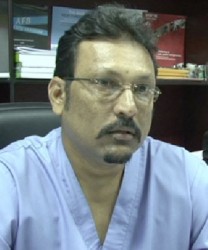The National Tuberculosis Programme has said that tuberculosis treatment under the Directly Observed Treatment Short (DOTS) course strategy has been successful in reducing the incidence of the disease in all but two regions, as Guyana observes World TB Day with a week of awareness activities.
This year, observances are being held under the theme ‘Reach the three million, find treat and cure TB’ and, as in previous years, Guyana will be hosting a week of awareness activities which started on Sunday with a fitness walk. Globally, World TB Day was observed on Monday, a report from the Government Information Agency (GINA) said.

The DOTS programme has been ensuring case detection, standardised treatment, with supervision and patient support, although it has not been as successful in regions Eight and Nine. Nevertheless, “Guyana is already showing a good trajectory of declining …incidence of TB. In 2013, alone there was a reduction in the number of cases; from 92 per a 100,000 population, in 2012 to 78 per 100,000 population in 2013.”
According to Dr Jeetendra Mohanlall, Programme Manager of the National Tuberculosis Programme, “Around the world globally each year we have nine million new cases of TB and approximately three million are not treated properly so we are missing one-third globally and even if persons are diagnosed they are not given appropriate treatment.”
Therefore, Guyana will be joining the global effort to reduce the number of TB cases by ensuring persons with TB are found, treated and cured. Dr Mohanlall is hopeful that the programme, in partnership with other stakeholders, will continue to work and that by the end of 2015 Guyana should see a reduction in new cases of TB from about 60 per 100,000 population. However, he emphasised that a lot of work is required to achieve this.
“We are hoping to scale up a lot of effort in TB, HIV/AIDS activities and we are working with the National AIDS Programme Secretariat (NAPS) to scale up activities to prevent TB in persons living with HIV,” Dr Mohanlall said.
It has been noted that HIV/AIDS has been one of the main factors fuelling the spread of TB in Guyana. While the DOTS strategy has been achieving its targets, strategic health communication and partnership in combating the joint challenges of HIV and TB Co-Infection and HIV and Diabetes co-infection remain critical. Despite this, there has been a slight decrease in the co-infection rate within the last two years from 29 per cent to 25 per cent.
According to Dr Mohanlall, other initiatives would be launched to build capacity in both the public and private sector with the aim of screening diabetic patients for TB. In recent times seven per cent of TB cases were found among diabetic patients.
Meanwhile, GINA noted that the week of activities to observe World TB Day started on Sunday with a fitness walk from the Ministry of Health’s Brickdam office and to army Base Camp Ayanganna where marchers and spectators were able to view two football matches at that location. On Monday, the National Tuberculosis Programme and the NAPS hosted a seminar where the Global AIDS report was discussed with various stakeholders. The week of activities will conclude with an appreciation ceremony which will highlight the contributions of staff and partners of the national programme.
Tuberculosis commonly called TB, is the cause of death of about 1.7 million people every year. Since 1982, March 24 has been earmarked as the day to boost public awareness about the global epidemic of TB and the efforts to eliminate this disease.
TB is generally classified as being either latent or active. Latent TB is where the bacteria are inactive but present in the body and the patient has no symptoms and is not contagious. Active TB is contagious. When an active TB infected person coughs, sneezes, shouts, or spits, bacteria can enter the air and come into contact with uninfected people who breathe the bacteria into their lungs and become infected.




